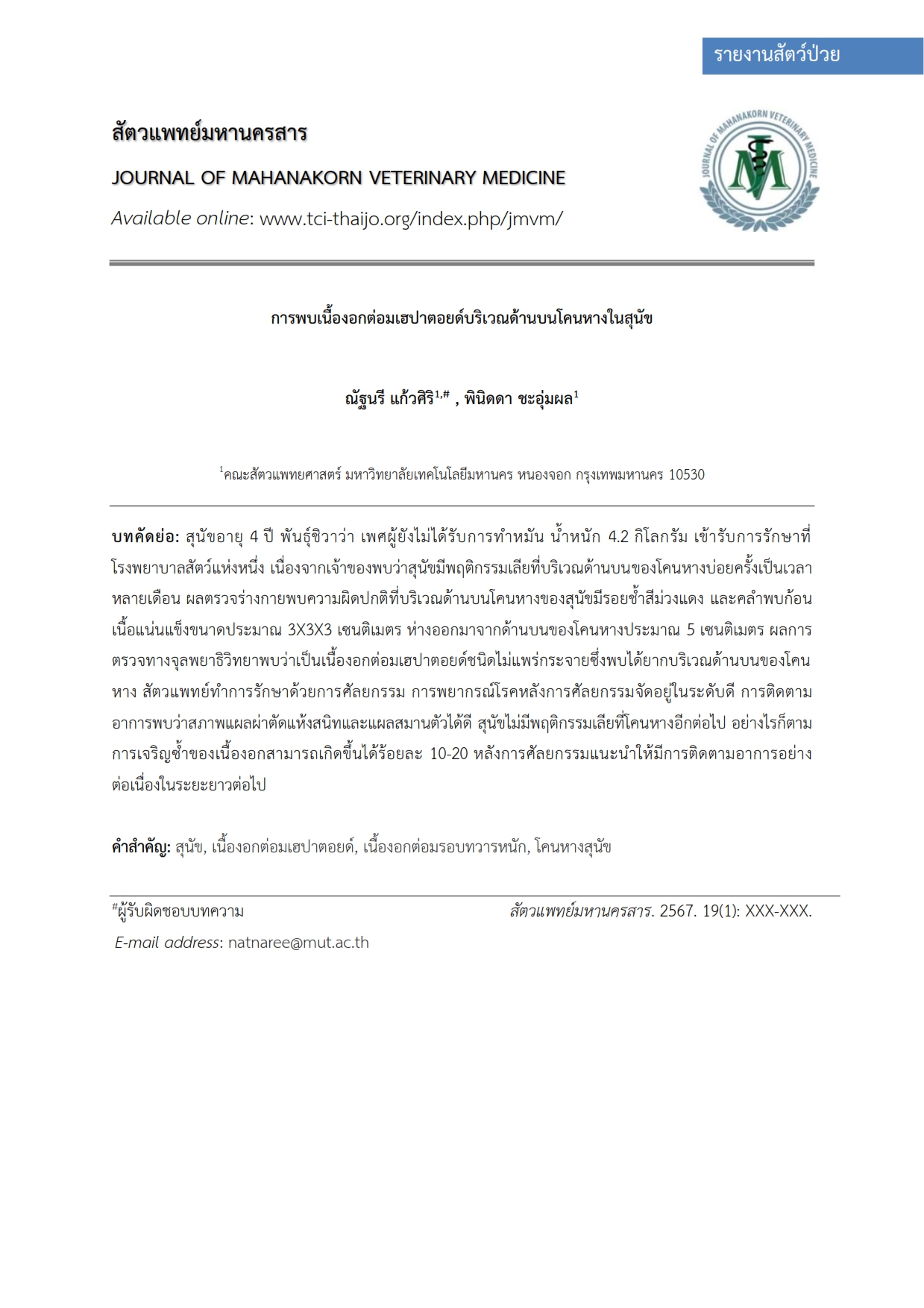การพบเนื้องอกต่อมเฮปาตอยด์บริเวณด้านบนโคนหางในสุนัข
Main Article Content
บทคัดย่อ
สุนัขอายุ 4 ปี พันธุ์ชิวาว่า เพศผู้ยังไม่ได้รับการทำหมัน น้ำหนัก 4.2 กิโลกรัม เข้ารับการรักษาที่โรงพยาบาลสัตว์แห่งหนึ่ง เนื่องจากเจ้าของพบว่าสุนัขมีพฤติกรรมเลียที่บริเวณด้านบนของโคนหางบ่อยครั้งเป็นเวลาหลายเดือน ผลตรวจร่างกายพบความผิดปกติที่บริเวณด้านบนโคนหางของสุนัขมีรอยช้ำสีม่วงแดง และคลำพบก้อนเนื้อแน่นแข็งขนาดประมาณ 3X3X3 เซนติเมตร ห่างออกมาจากด้านบนของโคนหางประมาณ 5 เซนติเมตร ผลการตรวจทางจุลพยาธิวิทยาพบว่าเป็นเนื้องอกต่อมเฮปาตอยด์ชนิดไม่แพร่กระจายซึ่งพบได้ยากบริเวณด้านบนของโคนหาง สัตวแพทย์ทำการรักษาด้วยการศัลยกรรม การพยากรณ์โรคหลังการศัลยกรรมจัดอยู่ในระดับดี การติดตามอาการพบว่าสภาพแผลผ่าตัดแห้งสนิทและแผลสมานตัวได้ดี สุนัขไม่มีพฤติกรรมเลียที่โคนหางอีกต่อไป อย่างไรก็ตามการเจริญซ้ำของเนื้องอกสามารถเกิดขึ้นได้ร้อยละ 10-20 หลังการศัลยกรรมแนะนำให้มีการติดตามอาการอย่างต่อเนื่องในระยะยาวต่อไป
Article Details

อนุญาตภายใต้เงื่อนไข Creative Commons Attribution-NonCommercial-NoDerivatives 4.0 International License.
เอกสารอ้างอิง
Chantawong, P, Mamom, T, Tangtrongsup, S,
and Boonsriroj, H. 2022. First study on
the immunohistochemical expression
of cyclooxygenase-2 and
clinicopathological association in
canine hepatoid gland neoplasms.
Veterinary World. 15(10): 2432-2441.
Hahn, KA. 2002. Veterinary oncology.
Butterworth-Heinemann: USA. 318 pp.
Lumley, JSP, Green, CJ, Lear, P and Angell-
James, JE. 1990. Essentials of
Experimental Surgery. Butterworth &
Co. Ltd: UK. 262 pp.
Millán, Y., Guil-Luna, S., Reymundo, C.,
Sánchez-Céspedes, R. and de las
Mulas, J.M. 2013. Sex Steroid
Hormones and Tumors in Domestic
Animals. In: Insights from Veterinary
Medicine. Intechopen: UK. p.191-214.
Morris, J and Dobson, J. 2001. Small Animal
Oncology. Blackwell Science Ltd: UK. 316 pp.
Papich, MG. 2021. Papich Handbook of
VETERINARY DRUGS. 5th ed. Elsevier, Inc.: Missouri. 1056 pp.
Plumb, DC. 2011. Plumb’s Veterinary Drug
Handbook. 7th ed. PharmaVet Inc.: Wisconsin. 1208 pp.
Shabeeba, PM, Sajitha, IS, Devi, SS, Divya, C
and Nair, SS 2021. Histopathological
study of canine hepatoid gland
tumours. Journal of Veterinary and
Animal Sciences. 52(3): 277-280.
Shoieb, AM and Hanshaw, DM. 2009. Anal
Sac Gland Carcinoma in 64 Cats in the
United Kingdom (1995–2007).
Veterinary Pathology. 46: 677-683.
Simon, M.S., Ramprabhu, R. and Pazhanivel,
N. 2017. Surgical Management of
Perianal Adenoma in a Dog. Intas
Polivet. 18(I): 200-201.
Sobczyńska-Rak, A, Żylińska, B, Jarosz, Ł,
Brodzki, A and Tatara, M. 2018. EGF Level in Hepatoid Gland Adenomas and Hepatoid Gland Epitheliomas in Dogs After Administering Tamoxifen. In Vivo. 32(5): 1175–1181.
Zanuto, EBM, Melo, SR, Januário, EV,
Fernandes, GAAL, and Matera, JM.
Diagnostic Value and
Application of Infrared Thermography
in the Analysis of Circumanal Gland
Tumors. Frontiers in Veterinary
Science. 8: 692221.


